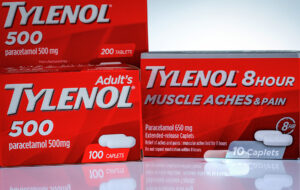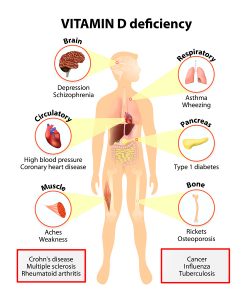Many women take acetaminophen when pregnant, but acetaminophen damages the fetus. It is important to realize that acetaminophen is a common over-the-counter pain reliever. In addition, it is also often combined with codeine as headache pills. Acetaminophen goes under these brand names: Tylenol, Tylenol Arthritis Pain, Tylenol Ext and Little Fevers Children’s Fever/Pain Reliever. The international name of acetaminophen is the name “paracetamol”.
An international group of 13 scientists are calling health care professionals to limit the use of acetaminophen in pregnant women. CNN reported about this under this link.
These scientists published an article in the medical journal Nature on the dangers of paracetamol use in pregnancy. Specifically, they said that acetaminophen can alter fetal development, which includes reproductive, neurodevelopmental and urogenital disorders.
History of acetaminophen
The chemical name for acetaminophen is N-acetyl-p-aminophenol. Acetaminophen is simply a shortened version of that chemical name. It was introduced in the US in 1955 as Tylenol® and in the United Kingdom in 1956 under the brand name Panadol®. In particular, acetaminophen was recommended to control fevers and to help with pain control.
In the 1960’s the Swiss watch industry provided workers who complained of headaches freely with acetaminophen. With this in mind, within a few years studies showed that many of these women who took a lot of this medication developed kidney problems. This led to an increase of the creatinine level in the blood. The kidney damage from acetaminophen was dubbed “phenacetin kidneys”. Outside of the US acetaminophen has the name phenacetin. Many of these patients subsequently had to receive dialysis and later kidney transplants.
Acetaminophen toxicity
The recommended dose of acetaminophen is 650 mg to 1000 mg 4-6 times daily, not to exceed 4 grams/day. The therapeutic window for this drug is very narrow, because 7.5 grams per day to 10 grams per day are already toxic. For children the dose is 15 mg/kg every 6 hours to a maximum of 60 mg/kg per day.
The other known toxicity concerns liver function. This article about Tylenol toxicity explains this in more detail.
Many people do not know about the limit for the over-the-counter acetaminophen and take too much for a fever or a painful condition. Just because a drug is available over the counter does not mean that it is harmless. If you don’t watch for toxic levels, you could end up dead or find yourself waiting for a liver transplant.
New evidence that acetaminophen damages the fetus
91 scientists from Australia, Brazil, Canada, Europe, Israel, Scotland, the UK and US have signed a declaration. In it they ask pregnant women not to take acetaminophen “unless its use is medically indicated”. Among the reasons for the declaration is that acetaminophen certainly can cause neural tube defects and cardiovascular disorders in fetuses. Pediatrician Dr. Leonardo Trasande, director of environmental pediatrics at NYU Langone Health, did not partake in this research. He has done safety studies on acetaminophen and pointed out the similarity in chemical structure between acetaminophen and phthalates. Like phthalates acetaminophen disrupts the reproductive development in animals and humans.
Evidence for neurodevelopmental disruption
Dr. Shanna Swan, a professor of environmental medicine at the Icahn School of Medicine at Mount Sinai in New York said: “There’s enough evidence to find increased risk of undescended testicles and a shortening of the anogenital distance, which is a predictive of later decreased sperm count and decreased fertility. We also see impaired ovarian function which has consequences for later fertility, although females have been less studied.”
The conditions that relate to acetaminophen toxicity were attention deficit hyperactivity disorder (ADHD), behavior abnormalities and autism spectrum disorders. In addition, language delays, conduct disorders and decreased IQ were due to neurodevelopment disruption from acetaminophen toxicity.
Mechanism of action of acetaminophen and side effects
Acetaminophen has been on the market for over 60 years. But scientists still don’t know exactly how it acts in the body to help control pain and reduce fever. There is a consensus that acetaminophen acts on the central nervous system inhibiting the synthesis of prostaglandins. These biological compounds have a leading role in causing fever, pain and inflammation. But the scientific proof for this consensus is still outstanding.
Side effects
There are a multitude of side effects that can occur with the use of acetaminophen. Common side effects are hives, itching, swelling of the mouth and throat and tingling in the mouth or throat. Other side effects are swelling in the face or hands, breathing difficulties or chest tightness. Acetaminophen can cause a loss of appetite, nausea and vomiting. Severe stomach pain can be another symptom of acetaminophen side effects. As you can see from the above link there are many more known side effects of acetaminophen.
Conclusion
Acetaminophen (=paracetamol, phenacetin) is a popular over-the-counter fever and pain remedy. But a narrow therapeutic width can cause serious overdoses where both the liver and the kidneys suffer irreparable damage. When people unknowingly take too much acetaminophen, they enter into the toxic range. This can cause disability and death. Kidney damage from acetaminophen became known as “phenacetin kidneys” already in the 1960’s in female workers of the watch industry in Switzerland. They developed headaches from constantly working with magnifying glasses and had free access to acetaminophen provided by the employer. Later, in North America liver disease developed when patients overdosed with over-the-counter acetaminophen for fever and pain control.
Interruption of fetal development from exposure of the fetus to acetaminophen
At the present time the focus is on newer findings of researchers. They noticed that exposure of pregnant women to acetaminophen damages the fetus. This results in undescended testicles and a shortening of the anogenital distance which is a predictive of later decreased sperm count and decreased fertility. These are findings for males. Findings in females are less studied at this point in time. Dr. Leonardo Trasande pointed out the similarity in chemical structure between acetaminophen and phthalates. Like phthalates acetaminophen disrupts the reproductive development in animals and humans. Patients should take acetaminophen only under supervision with doses that are safe. The old notion that acetaminophen would be safe in pregnancy is no longer true in light of the new medical findings. Any pregnant woman should discuss with her physician what she can safely take.








